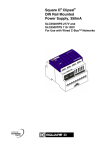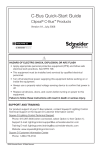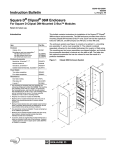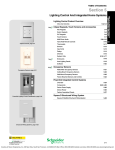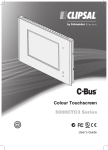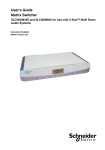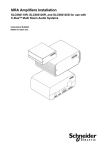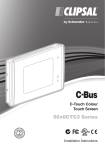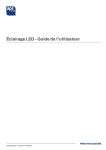Download Clipsal 5070THB Series Instruction manual
Transcript
® Clipsal Basic Single Zone Thermostat SLC5070THB and SLC5070THBR Instruction Bulletin Retain for future use. Clipsal® Basic Single Zone Thermostat Instruction Bulletin 63249-420-294A2 08/2008 HAZARD CATEGORIES AND SPECIAL SYMBOLS Read these instructions carefully and look at the equipment to become familiar with the device before trying to install, operate, service, or maintain it. The following special messages may appear throughout this bulletin or on the equipment to warn of potential hazards or to call attention to information that clarifies or simplifies a procedure. The addition of either symbol to a “Danger” or “Warning” safety label indicates that an electrical hazard exists which will result in personal injury if the instructions are not followed. This is the safety alert symbol. It is used to alert you to potential personal injury hazards. Obey all safety messages that follow this symbol to avoid possible injury or death. Danger indicates an immediately hazardous situation which, if not avoided, will result in death or serious injury. Warning indicates a potentially hazardous situation which, if not avoided, can result in death or serious injury. Caution indicates a potentially hazardous situation which, if not avoided, can result in minor or moderate injury. Caution, used without the safety alert symbol, indicates a potentially hazardous situation which, if not avoided, can result in property damage or improper operation. NOTE: Provides additional information to clarify or simplify a procedure. 2 © 2008 Schneider Electric. All Rights Reserved. 63249-420-294A2 08/2008 Clipsal® Basic Single Zone Thermostat Instruction Bulletin PLEASE NOTE Electrical equipment should be installed, operated, serviced, and maintained only by qualified personnel. This document is not intended as an instruction manual for untrained persons. No responsibility is assumed by Square D for any consequences arising out of the use of this manual. Class B FCC Statement This equipment has been tested and found to comply with the limits for a Class B digital device, pursuant to Part 15 of the FCC Rules. These limits are designed to provide reasonable protection against harmful interference in a residential installation. This equipment generates, uses, and can radiate radio frequency energy and, if not installed and used in accordance with the instructions, may cause harmful interference to radio communications. However, there is no guarantee that interference will not occur in a particular installation. If this equipment does cause harmful interference to radio or television reception, which can be determined by turning the equipment off and on, the user is encouraged to try to correct the interference by one or more of the following measures: • Reorient or relocate the receiving antenna. • Increase the separation between the equipment and receiver. • Connect the equipment into an outlet on a circuit different from that to which the receiver is connected. • Consult the dealer or an experienced radio/TV technician for help. © 2008 Schneider Electric. All Rights Reserved. 3 Clipsal® Basic Single Zone Thermostat Instruction Bulletin 63249-420-294A2 08/2008 INTRODUCTION Clipsal® Basic Thermostats are used to regulate the air temperature of a single zone by controlling heating/ventilation/air conditioning (HVAC) equipment. The unit monitors the air temperature using its internal temperature sensor. The SLC5070THBR model has built-in relays that can be connected directly to a HVAC system that uses a standard 24 V AC RWG interface. Figure 1: Clipsal® Basic Single Zone Thermostat (SLC5070THBR) with built-in relays Figure 2: The Clipsal® Basic Single Zone Thermostat (SLC5070THB) with external C-Bus relays KEY: A. Basic thermostat (SLC5070THB) B. C-Bus C. HVAC connections D. Voltage Free Relay with C-Bus Power Supply 4 © 2008 Schneider Electric. All Rights Reserved. 63249-420-294A2 08/2008 Clipsal® Basic Single Zone Thermostat Instruction Bulletin Before You Begin Before you begin to set up a unit, verify that your order is complete by comparing the contents of the package with the appropriate items in the table below. Also verify that the catalog number on the box label matches your order. Contents of the Box Table 1: Contents of the Box Part Number Description Quantity SLC5070THB or SLC5070THBR* C-Bus Basic Single Zone Thermostat 1 *SLC5070THBR has built-in HVAC control relays. SAFETY PRECAUTIONS This section contains important safety precautions that must be followed before attempting to install or maintain electrical equipment. Carefully read and follow the safety precautions below. HAZARD OF ELECTRIC SHOCK, EXPLOSION, OR ARC FLASH • Apply appropriate personal protective equipment (PPE) and follow safe electrical work practices. See NFPA 70E. • This equipment must be installed and serviced by qualified electrical personnel. • Turn off all electrical power supplying this equipment before working on or inside the equipment. • Always use a properly rated voltage sensing device to confirm that power is off. • Replace all devices, doors, and covers before turning on power to this equipment. Failure to follow these instructions will result in death or serious injury. © 2008 Schneider Electric. All Rights Reserved. 5 Clipsal® Basic Single Zone Thermostat Instruction Bulletin 63249-420-294A2 08/2008 SELECTING A LOCATION Follow these guidelines when selecting a location: • Provide easy access to the unit. • Avoid water, humidity, direct sunlight, and heavy dust. • Leave the unit uncovered to allow adequate ventilation. • Only use the thermostat indoors. • Adhere to all specifications in this manual. • Avoid proximity to HVAC diffusers. • Ensure the temperature sensor is mounted in a position suitable for measuring the environment being temperature controlled. This applies to the thermostat's internal sensor or to an external C-Bus temperature sensor (whichever is used). INSTALLATION Network Considerations The Desktop Touchscreen can draw 40 mA from the C-Bus network. Determine the total network current load and verify that there will be enough C-Bus power to support all connected devices. Also verify that the amount of available power per C-Bus network is no more than 2A. C-Bus System Clock The thermostat has a software-selectable C-Bus system clock with the capability to synchronize data communication on the C-Bus network. Typically the clock is disabled: Successful C-Bus network communications require only one active clock. A maximum of three C-Bus units per network can have the clock enabled. Refer to the CBus Toolkit software for additional information and to enable the thermostat system clock. 6 © 2008 Schneider Electric. All Rights Reserved. 63249-420-294A2 08/2008 Clipsal® Basic Single Zone Thermostat Instruction Bulletin Mounting Instructions Mount the unit on any wall surface using the appropriate hardware (not provided). Do not recess the unit into a wall because the side air vents must be exposed. Mounting diagrams are provided in Figure 3 and 4. 1. Insert a flat head screwdriver into the notches at the bottom of the thermostat and gently pry the base plate off the unit. 2. Prepare the mounting surface using the base plate to mark mounting hardware locations. 3. Place the base plate over the mounting surface and feed the cables through. 4. Screw the base plate to the mounting surface. 5. Wire the appropriate conductors to the terminals. 6. Align the thermostat over the base plate and push to reattach. Figure 3: Mounting the SLC5070THBR base plate (C-Bus and example HVAC wiring) NOTE: HVAC relay terminal wiring will vary depending on the HVAC system installed. © 2008 Schneider Electric. All Rights Reserved. 7 Clipsal® Basic Single Zone Thermostat Instruction Bulletin 63249-420-294A2 08/2008 Figure 4: Mounting the 5070THB base plate (C-Bus wiring) Network Burden One network burden is required for proper C-Bus operation, network termination, and biasing. HAZARD OF IMPROPER OR UNSTABLE OPERATION C-Bus networks require only one burden. Failure to follow this instruction can result in improper C-Bus network operation. The C-Bus system clock must be enabled in order to apply the network burden. 8 © 2008 Schneider Electric. All Rights Reserved. 63249-420-294A2 08/2008 Clipsal® Basic Single Zone Thermostat Instruction Bulletin Hardware Burden The hardware burden can be used in one of two ways. 1. Install the hardware burden temporarily in order to enable the software burden, and then to remove the hardware burden. 2. Install the hardware burden and leave it installed as the network burden. To install the hardware burden device, simply plug it into the C-Bus network RJ-45 receptacle. NOTE: Plug the hardware burden device only into C-Bus receptacles. Figure 5: Hardware Burden Connection on the Unit KEY: A. RJ-45 C-Bus receptacle on the unit B. Hardware burden Configuring, Labeling, and Recording the Locations of C-Bus Units C-Bus units must be configured, at a minimum, with the unit address and part name before being physically installed on the network. Each unit is identified by a unique serial number found on the box label (see the figure “Example of a Box Label with Lift-and-Peel Section”). The serial number provides important information for recording a unit's location. An infrared barcode scanner may be used to read the box label's bar code for the serial number and unit information. Use the C-Bus Toolkit to assign the unit a unique address, and then mark the unit address and part name directly onto the unit before physical installation. You can use the lift-and-peel label from the unit box, or write the unit address and part name directly on the unit. © 2008 Schneider Electric. All Rights Reserved. 9 Clipsal® Basic Single Zone Thermostat Instruction Bulletin 63249-420-294A2 08/2008 After marking the unit, record each unit's physical location onto a site plan or panel schedule. Figure 6: Example of a Box Label with Lift-and-Peel Section KEY: A. Serial number B. Bar code C. Lift-and-peel section HAZARD OF UNEXPECTED OR UNINTENDED OPERATION • Properly configure, label, and record the location of each unit. • Retain location records and provide them to the person(s) responsible for configuring and commissioning the network. Failure to follow these instructions can result in unintended C-Bus network operation. 10 © 2008 Schneider Electric. All Rights Reserved. 63249-420-294A2 08/2008 Clipsal® Basic Single Zone Thermostat Instruction Bulletin HVAC CONNECTION HAZARD OF IMPROPER OPERATION OR EQUIPMENT DAMAGE. • Refer to the HVAC installation instructions before connecting the wiring. • When the thermostat is connected to HVAC equipment, do not press the thermostat's power button until C-Bus programming is complete. Failure to follow these instructions will result in damage to the HVAC equipment or thermostat. Interfacing the thermostat with HVAC equipment requires physical wiring and C-Bus programming. The thermostat can be wired to HVAC equipment that uses a standard air conditioning RWG/RWGY control interface. It can also be wired to some other HVAC systems, depending on their wiring (refer to the manufacturer's wiring diagram or application notes). Examples of connection scenarios for standard RWG/RWGY systems are provided in this section. They use a thermostat with built-in relays. In each case, a thermostat and C-Bus Voltage Free Relay combination may be used instead. The thermostat provides five relay channels (RL1, RL2, and RL3 are looped to Rc; RL4 and RL5 looped to Rh.) An external C-Bus Voltage Free Relay may be used to provide any additional relay channels. © 2008 Schneider Electric. All Rights Reserved. 11 Clipsal® Basic Single Zone Thermostat Instruction Bulletin 63249-420-294A2 08/2008 Refer to the HVAC installation instructions for wiring details specific to your system. Figure 7: Connecting to a 2-stage conventional A/C which uses RWG control Figure 8: Connecting to a reverse cycle AC that uses RWG control Figure 9: Connecting to a hydronic heating system that uses RWG control 12 © 2008 Schneider Electric. All Rights Reserved. 63249-420-294A2 08/2008 Clipsal® Basic Single Zone Thermostat Instruction Bulletin Figure 10: Connecting to an evaporative cooler that uses RWG control Figure 11: Connecting to the AC system shown in Figure 10 © 2008 Schneider Electric. All Rights Reserved. 13 Clipsal® Basic Single Zone Thermostat Instruction Bulletin 63249-420-294A2 08/2008 Figure 12: Connecting to a fan coil cooling system that uses RWG control Figure 13: Connecting to separate RWG based cooling and heating systems Figure 14: Example AC system without standard RWG control 14 © 2008 Schneider Electric. All Rights Reserved. 63249-420-294A2 08/2008 Clipsal® Basic Single Zone Thermostat Instruction Bulletin WIRING GUIDELINES Follow the guidelines below when working with the thermostat. • Verify that the power supplying the system is turned OFF before handling electrical power conductors. • Observe national and local electrical codes. • Isolate the thermostat from the Class 1 wiring. Consult your national and local electrical codes for requirements about isolating Class 1 wiring and Class 2 wiring terminals. • Consult the "Electrical Wiring Connections" figure for all electrical connections. • Prevent wire cuttings and debris from entering the unit. • Use suitably rated copper wire, #18 - 22 AWG (0.82mm² 0.33mm²). MEGGER® TESTING GUIDELINES Do not Megger® test C-Bus data cabling or terminals. Megger testing of data cabling or terminals can degrade the performance of the C-Bus network. It will not harm the units if electrical power terminals only are Megger tested. But because units contain electronic components, the Megger readings will not be correct. To obtain valid readings, disconnect the power lines from the units. HAZARD OF EQUIPMENT DAMAGE Do not Megger® test C-Bus data cabling or terminals as it can degrade the performance of the C-Bus network. Failure to follow this instruction will result in damage to the C-Bus network. © 2008 Schneider Electric. All Rights Reserved. 15 Clipsal® Basic Single Zone Thermostat Instruction Bulletin 63249-420-294A2 08/2008 CONNECTION TO THE C-BUS NETWORK The thermostat is connected to the C-Bus network through a C-Bus network cable that uses unshielded twisted pair (UTP) Category 5 data cable. For optimal performance, use the connections recommended below for each end of the cable. Attach the bootlace terminals to the twisted pairs of the C-Bus network cable. NOTE: The C-Bus network connection is polarity sensitive. The polarity is marked on the unit beside the terminals. NOTE: Do not solder wires used to connect the unit to the C-Bus network through the terminal block connections. HAZARD OF ELECTRIC SHOCK, EXPLOSION, OR ARC FLASH Do not connect line voltage to any C-Bus terminal. Failure to follow this instruction can result in personal injury or equipment or property damage. Figure 15: C-Bus Wiring Connections KEY: A. C-Bus positive (+) B. C-Bus negative (–) C. Remote OFF: brown + brown-white* D. Remote ON: green + green-white* 16 © 2008 Schneider Electric. All Rights Reserved. 63249-420-294A2 08/2008 Clipsal® Basic Single Zone Thermostat Instruction Bulletin Table 2: C-Bus Cable Conductor Assignments Terminal C-Bus Network Connection Cable Color Not connected Remote ON* Green-White Not connected Remote ON* Green C-Bus Neg (–) C-Bus Neg (–) Orange-White C-Bus Neg (–) C-Bus Neg (–) Blue-White C-Bus Pos (+) C-Bus Pos (+) Blue C-Bus Pos (+) C-Bus Pos (+) Orange Not connected Remote OFF* Brown-White Not connected Remote OFF* Brown *Not internally connected. SPECIFICATIONS Table 3: Operating Specifications Parameter C-Bus supply voltage Description 15 to 36 V DC, 40 mA Does not provide current to the C-Bus network C-Bus AC input impedance Relays (SLC5070THPR) 50 kΩ @ 1 kHz Each relay rated at 2 A @ 24 V AC 3750 V isolation between terminals and C-Bus C-Bus connection One terminal block to accommodate 0.2 to 1.3 mm2 (16 to 24 AWG) Temperature sensor accuracy +/- 0.9 F° (+/- 0.5 C°) Operating temperature 14 to 122 °F (-10 to 50 °C) Operating humidity 10 to 95% RH © 2008 Schneider Electric. All Rights Reserved. 17 Clipsal® Basic Single Zone Thermostat Instruction Bulletin 63249-420-294A2 08/2008 DIMENSIONS STANDARDS The thermostat complies with the following Standards: Table 4: U.S. and Canadian Product Safety Standards and U.S. FCC Regulations Standards/Regulations 18 Title CSA C22.2 No. 205 Signal Equipment UL916 Energy Management Equipment FCC Part 15 Class B Digital Device for Home or Office Use © 2008 Schneider Electric. All Rights Reserved. Clipsal® Basic Single Zone Thermostat Instruction Bulletin SUPPORT AND SERVICE Contact the Square D Customer Information Center for technical support by phone at 1-888-Square D (1-888-778-2733) or e-mail at [email protected]. ® Contact your local Square D service representative or Square D Clipsal® certified installer for repairs or service to your network. You may also find helpful information on our web site at www.squaredlightingcontrol.com. Schneider Electric, USA 295 Tech Park Drive La Vergne, TN, 37086 1-888-SquareD (1-888-778-2733) www.squaredlightingcontrol.com Electrical equipment should be installed, operated, serviced, and maintained only by qualified personnel. No responsibility is assumed by Schneider Electric for any consequences arising out of the use of this material. Square D, , Clipsal, C-Bus, Saturn and Neo are trademarks or registered trademarks of Schneider Electric and/or its affiliates in the United States and/or other countries. © 2008 Schneider Electric. All Rights Reserved. 63249-420-294A2 08/2008





















